By Eric Vandenbroeck and co-workers
The Making Of The Modern Middle East
Part Two
In Part One
we detailed the fall of the Ottoman Empire and the Sharif Hussein
Arab Revolt. In Part Two the carving up of the Middle East via
the Sykes-Picot Agreement.
As we have
seen Hussein declared himself “King of
the Arabs” in October 1916 (although he was only recognized as King of the
Hejaz by his European allies). In December 1917, the Sharif put forward an
ambitious scheme for ruling Arabia (north of Aden, which he recognized as a
British preserve) and the Fertile Crescent as the first among equals of an Arab
confederacy. His revolt took the form of a traditional Arabian “chieftaincy”
rather than that of a modern nationalist movement. British-supplied guns,
grain, and gold were used to construct a ladder of Bedouin support that
extended into southern Syria after the capture of Aqaba in July
1917. Hussein’s forces failed to take Medina (which held out until
January 1919) or to progress north of Ma‘an before the Ottoman collapse in
November 1918 opened the way for their triumphal entry into Damascus – an
occasion that Hussein marked by annexing Ma‘an and its hinterland
(including Aqaba) to the Hejaz.
The Fate Of Hussein’s Revolt
The Arab movement was
a loose one and proved fragile even under wartime conditions when British gold
flowed freely. Many of Hussein’s tribal clients defected once his forces passed
beyond their territories. Held together by a temporary influx of British gold, Hussein’s
movement proved even more fragile once external support began to drain away in
the aftermath of the war. Bereft of financial means, Hussein’s Hashemite
chieftaincy proved less durable than that forged out of Wahhabi Islam and the
zeal of the fearsome Ikhwan by Ibn Saʻud. In May
1919, a dispute over the town of Khurma on the border
between Najd and the Hejaz escalated into an armed conflict that saw the
destruction of Hussein’s army by the Ikhwan at the battle of Turaba. The Saudi victory paved the way for the slow
“crawl” of Wahabism into the hinterlands of the Hejaz and Ibn Sau’d’s eventual destruction of Hussein’s kingdom in
1925. Despite the installation of his sons, Abdullah, King of Jordan
(1882-1951), and Faysal I, King of Iraq (1885-1933), as rulers of
Transjordan and Iraq under British Mandate tutelage, Hussein spent
the rest of his life in exile in Cyprus, returning to die in Amman.
Having launched his
uprising against Ottoman rule with British prompting, Hussein ended
up as the chief victim of a postwar settlement that saw Britain
renege on the promises of Arab independence held out by his correspondence with McMahon. A later generation of
Arabs came to condemn the movement he launched as a reactionary affair that
had, in practice, delivered the Fertile Crescent to colonial rule. Yet while
there may be some grounds for leveling this accusation against Hussein’s
sons, the record shows that Hussein refused to adapt to the European
order that emerged from the wreckage of the Ottoman Empire. In particular,
he refused to recognize the British Mandate as
the price of protection from the menace of Ibn Saʻud.
Having sacrificed a millennium of Sharifian rule over Islam’s two most holy
shrines on a matter of principle, it is perhaps apt that Hussein was
buried in Islam’s third most holy place in Jerusalem, on the grounds of the
Dome of the Rock, his grave a standing reproach to the imperial power that used
and then abandoned him.
The Mandate aimed to
administer and develop the region until it was ready for self-determination.
The Mandate ended in 1948, when Israel declared its independence and Arab
states invaded the territory.
The agreement was based on the premise that the Triple Entente would achieve success in defeating the
Ottoman Empire during World War I and formed part of a series of secret
agreements contemplating its partition. The primary negotiations leading to the
agreement took place between 23 November 1915 and 3 January 1916, on which date
the British and French diplomats, Mark Sykes and François
Georges-Picot, initiated an agreed memorandum.1
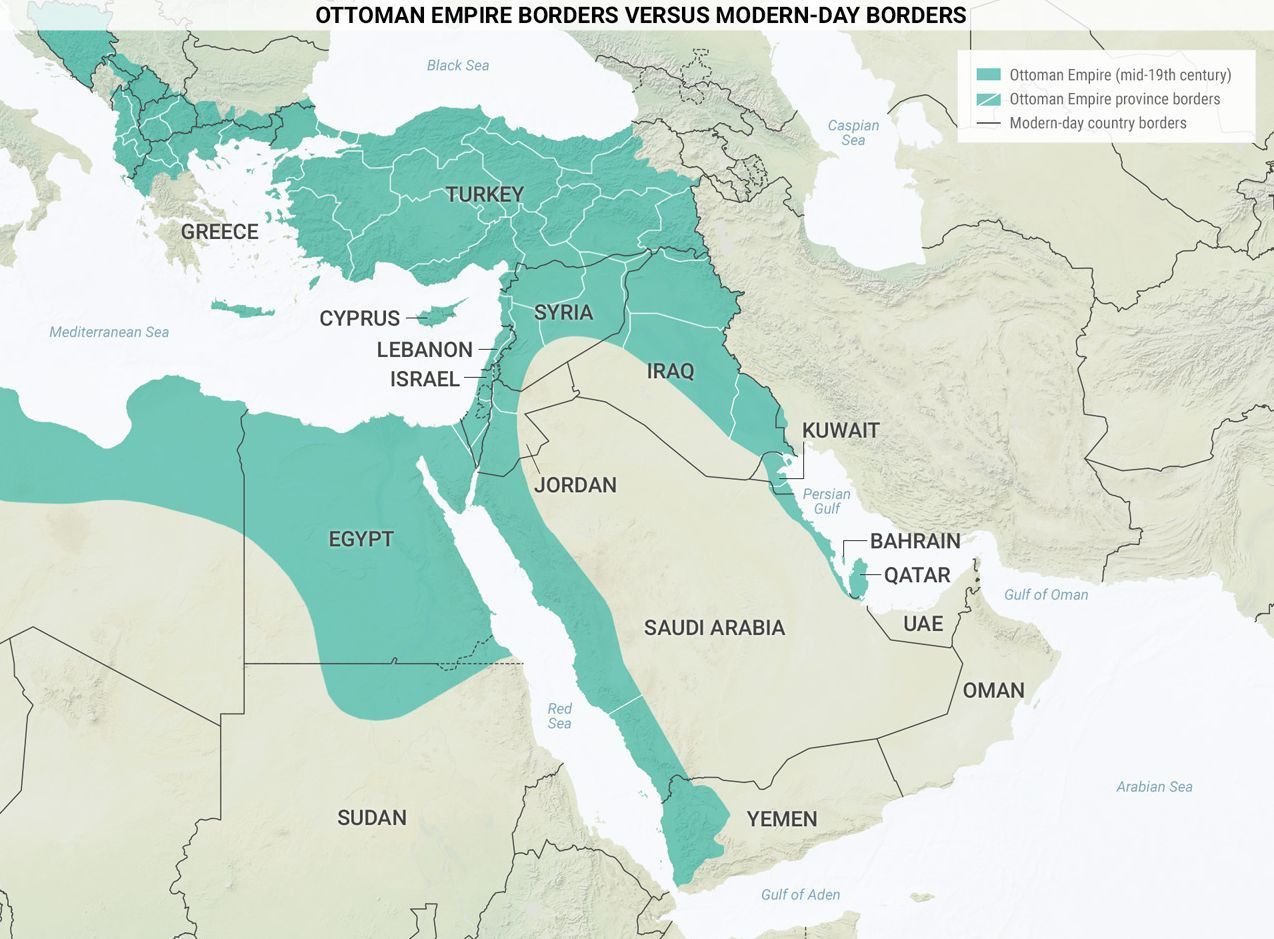
The first meeting of the British
interdepartmental committee headed by Sir Arthur Nicolson with François
Georges-Picot took place on 23 November 1915. The French representative was not
convinced of the importance of inducing the Emir of Mecca and the Arab
nationalists to side with the Entente. Austen Chamberlain reported to Lord
Hardinge that Picot had ‘expressed complete incredulity as to the projected
Arab kingdom, said that the Sheikh had no big Arab chiefs with him, that the
Arabs were incapable of combining, and that the whole scheme was visionary’.
The secretary of state for India was very pleased. It seemed that the French
delegate ‘knows his Arab well. I expect he has sized up the Sheikh’s scheme
pretty accurately. I doubt if it has any element of solidity or that any
promise will have weight with the Arabs until they are convinced that we are
winning.’2
Moreover, French
demands – which according to Picot the French were obliged to make as ‘no
French government would stand for a day which made any surrender of French
claims in Syria’ – were rather excessive. Picot informed the Nicolson committee
that France claimed the: Possession (nominally, a protectorate) of
land starting from where the Taurus Mts approach the sea in Cilicia, following
the Taurus Mountains and the mountains further East, to include Diabekr, Mosul, and Kerbela, and then returning to Deir Zor
on the Euphrates and from there southwards along the desert border, finishing
eventually at the Egyptian frontier. Picot, however, added that he
was prepared ‘to propose to the French government to throw Mosul into the Arab
pool if we did so in the case of Bagdad’. In amplification, Nicolson minuted that Picot had: Intimated his
readiness to proceed to Paris to explain personally our view – and the Arab
desiderata. M. Cambon told me that he had objected to this visit, on the ground
that he would not be well received at the Quai d’Orsay were he to carry with
him such unpalatable proposals as he had suggested. M. Picot would, therefore,
communicate with Quai d’Orsay in writing. We must, therefore, await the
reply.15
Thus started the
negotiations between the British and the French, subsequently followed by the
British, the French, and the Russians, to settle their claims on the Asiatic
part of the Ottoman Empire. The Foreign Office started these negotiations
because it considered that they had to be brought to a successful conclusion
before the Emir of Mecca could again be approached regarding the terms under
which the Arabs would be pre- pared to side with the Entente. A settlement
should also secure French consent to a military intervention on the coast of
Syria, providing a screen behind which the Arabs would rise against the Turks.
During the negotiations, which started at the end of November 1915 and finally
came to an end in the middle of May 1916, Sir Edward Grey and his officials
again and again stipulated that an agreement only held good if the active
cooperation of the Arabs was secured. At the same time they were well aware
that, after the British and French governments had decided at the end of
December 1915 to concentrate their forces on the Western front and that the
amount of troops on the other fronts should be reduced to the barest minimum, a
military intervention on the Syrian coast was out of the question and Arab
active assistance consequently would never materialize. This had at least the
advantage that critics of the negotiations could easily be disarmed by pointing
out that nothing would ever come of all this. Not three weeks after an exchange
of letters between Grey and French ambassador Paul Cambon had finalized what
would become known as the Sykes–Picot agreement, Sharif Hussein started his
revolt against his Turkish masters. That the Emir revolted without waiting for
a fresh round of negotiations or a military intervention by the Entente drew no
comments from Grey and his officials.
The Cairo authorities
to impress on the Foreign Office that the object of the negotiations with
Hussein was not to gain the Arabs’ active assistance, but rather their passive
support in order to prevent a jihad. They also tried to make clear to the home authorities
that Arab opposition to French ambitions in Syria was real and could not be
ignored, that there were divisions in the Arab nationalist camp, and that as a
result of a rapprochement between the Turkish opposition parties and the Arab
nationalists, it was inopportune to divulge the terms of the Sykes–Picot
agreement to Hussein. The main result of these efforts to educate Grey and his
officials on the true state of Arab feeling was that the latter grew heartily
tired of the whole affair.
There were also the various crises that
erupted in London from September 1916 to January 1917 as a result of a series
of requests by the authorities in Cairo and Khartoum to send a British brigade to the town of Rabegh on
the coast of the Hijaz to prevent the Turks from advancing on Mecca
and crushing Sharif Hussein's revolt. These requests offered ministers
dissatisfied with how the war was being conducted the opportunity to challenge
the established military policy of concentrating all available forces on the
Western front in France. However, to overthrow this policy was quite another
matter. At times, the War Committee hovered on the brink, but in the end, it
always decided to postpone the decision, even when it had been decided to take
a decision. When in December the newly created War Cabinet decided to delegate
the responsibility for sending the brigade to Sir Reginald Wingate, the latter,
although he had been the most ardent advocate of the scheme, promptly shifted
it onto Hussein, who in the meantime had been proclaimed ‘King of the Arab
Nation’, his precarious position notwithstanding. By the middle of January
1917, it was evident that Hussein would not permit British troops to land in
the Hijaz. This proved to Wingate’s satisfaction that, if the Arab revolt
collapsed, the blame lay firmly on Hussein’s shoulders. There would be no
further Rabegh scares.
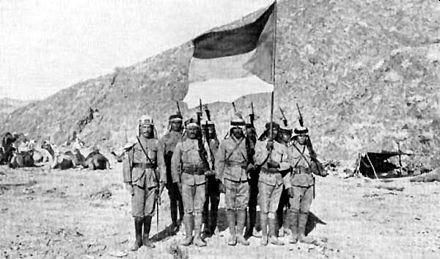
Soldiers carrying the Flag of the Arab Revolt.
Meanwhile, Mark Sykes traveled to see Hussein and
managed to convince the king that he could safely assent to a formula to the
effect that the French would pursue the same policy in Syria as the British in
Baghdad. Hussein had apparently gained the impression that Baghdad would be
part of the Arab state, and afterwards showed himself to be very pleased that
he had tricked Picot into giving Syria away. According to the Sykes–Picot agreement, however, Baghdad would be
‘practically British’, in which case the king had unwittingly agreed to Syria
being ‘practically French’. It did not take long before the Foreign Office
received the first reports indicating that, as far as informing King Hussein of
the terms of the Sykes–Picot agreement was
concerned, the Sykes–Picot mission had been a signal failure.
Having discussed the previous month Mark
Sykes is one of the more fascinating persons figuring in British policy making
towards the Middle East 1914–19. At the beginning of 1916, Sykes
established a reputation as an effective negotiator. His reputation was further
strengthened by his appointment as assistant secretary to the War Cabinet, but
it began to wane when in the summer of 1917 there were signs that he had failed
to impart to King Hussein a clear understanding of what the Sykes–Picot
agreement meant, and it was fatally injured at the end of 1917, when it became
clear that the French government would not ratify the projet d’arrangement Sykes had negotiated. What makes Sir
Mark fascinating is that he did not hesitate to put the most fantastic,
outrageous observations, theories and schemes to paper and circulate them to
whomever might be interested. His observations on the influence of the Jews on
the war efforts of the belligerents did perhaps not raise too many eyebrows,
because these were very common at the time, but this certainly did not apply to
his various schemes about how French, Arab, Armenian, Zionist and whoever
else’s interests could be combined and reconciled, and put to work in support
of the British war effort. It is hard to believe that anyone for one moment
took these seriously, or was ready to entertain them, but it was very seldom
that they were openly ridiculed.
As for Hussein there
also was, of course, the question of money. Clayton informed Wingate that
Hussein Hussein had: Confessed
to Wilson that he had saved about £200,000 out of the first two consignments of
£125,000 sent to him, and Faisal was exceedingly angry at the difficulty he had
in getting money out of his father for himself and Ali […] £100,000
golden sovereigns sent to Feisal and Ali a couple of months ago would have
done wonders. Wilson has spoken very seriously to the Sharif and is going to do
so again and warn him that he is jeopardizing his success by his
parsimony.16
On 10 April 1917,
Wingate telegraphed to the Foreign Office that Hussein had requested that his
monthly subsidy is raised. According to the high commissioner, the King
deplored the fact that he had to make this request, especially given ‘his heavy
financial and other obligations to His Majesty’s Government’, but then again,
from his revolt ‘serious political and military benefits’ had accrued to Great
Britain. Sir Reginald added that Hussein would use the extra money ‘to secure
the adhesion of chiefs of northern tribes and thereby to achieve that semblance
of national cohesion which can (?justify) his revolt […] in the eyes of the
Moslem world’. Given the latter, in particular, it seemed to Wingate to ‘be bad
and possibly dangerous policy on our part to withhold additional financial
backing which he requires at a time when tribal elements east of the Jordan can
render effectual assistance to our own military operations in Palestine.' He,
therefore, did not hesitate to recommend strongly the granting of Hussein’s
request.
During the summer and
autumn of 1917, officials of the Foreign Office, the India Office, the War
Office and the Treasury met regularly to discuss the situation, while Sir
Reginald time and again tried to force the issue. On 18 June, Wingate urged
that Hussein’s ‘monetary requirements’ be met to prevent unfortunate political
effects ‘on Arab military operations’, and one month later he stated that not
meeting Hussein’s demands ‘would be little short of disastrous and effect on
Arab military operations hardlyless so’.17 The Arab
revolt, however, still continued when on 10 October the Treasury
finally agreed to place £400,000 in gold at the disposal of the Egyptian
treasury.18 This matter had hardly been settled when Sir Reginald asked
permission that ‘additional £25,000 a month which has already been promised to
Shereef for five months after fall of Medina be given him now, and that it be
continued for a maximum period of 5 months irrespective of date on which Medina
may fall’. The high commissioner fully realized that ‘Shereef’s method of
administering his finances is by no means beyond criticism’, but the situation
in the Hijaz once again was ‘critical’, and it was Wingate’s considered opinion
that Great Britain should not, ‘for the sake of a relatively small sum of
money, lose the full fruits of a policy which I venture to think has fully
justified itself both from a military political and financial point of view’.
This was exactly what was bothering Clerk. He doubted very much ‘if another
£25,000 a month is going to keep the Arabs together, supposing they are in the
condition Sir R. Wingate describes’. He wondered whether the time had not
arrived that ‘we should rely on our forces and refuse to be a milk cow for King
Hussein’. Graham had no difficulty with the proposal, as it was the high
commissioner’s responsibility, but he agreed with Clerk that ‘the Arab movement
must be very unstable if £25,000 a month makes all the difference to it!’19
However, the authorities in Cairo, Baghdad, and London
steadily lost their grip on the continuing and deepening rivalry
between Hussein and Ibn Sa’ud, in
particular regarding the possession of the desert town of Khurma. This led to the First Saudi–Hashemite War, also
known as the First Nejd–Hejaz War.
The war came within
the scope of the historical conflict between the Hashemites of Hejaz and the
Saudis of Riyadh (Nejd) over supremacy in Arabia. It resulted in the defeat of
the Hashemite forces and capture of al-Khurma by
the Saudis and his allied Ikhwan, but British intervention prevented an
immediate collapse of the Hashemite kingdom, establishing a sensitive
cease-fire.
The British–French
rivalry in the Hijaz; the British attempt to get the French government to
recognize Britain’s predominance on the Arabian Peninsula; the conflict between
King Husayn and Ibn Sa’ud, the Sultan of Najd;
the British handling of the French desire to take part in the administration of
Palestine; as well as the ways in which the British authorities, in London and
on the spot, tried to manage French, Syrian, Zionist and Hashemite ambitions
regarding Syria and Palestine, in the end, has two major underlying themes. The
first is the rapid erosion of Sir Mark Sykes’s authority on Middle Eastern
affairs in the months from December 1917 to August 1918. His proposed solutions
for the disentanglement of the mass of knotty problems with which Britain was
confronted found less and less favor and were increasingly ignored or rejected.
At the end of this period, Sir Mark stood more or less on the sidelines of the
decision-making process regarding the Middle East. There is quite some irony
here, like Sykes, at his request, had moved to the Foreign Office at the
beginning of January 1918 in an attempt to become the directing actor in
British Middle East policy. The second underlying theme concerns the
concomitant undermining of the Foreign Office doctrine that no effort should be
spared to accommodate French susceptibilities on Syria. In Cairo and Palestine,
Sir Reginald Wingate, Gilbert Clayton and General Allenby championed the cause
of the Arabs, sheltering behind military exigencies, while in London, Arthur Balfour
and Lord Robert Cecil failed to put their stamp on the decision making within
the inter-departmental Eastern Committee chaired by Lord Curzon.
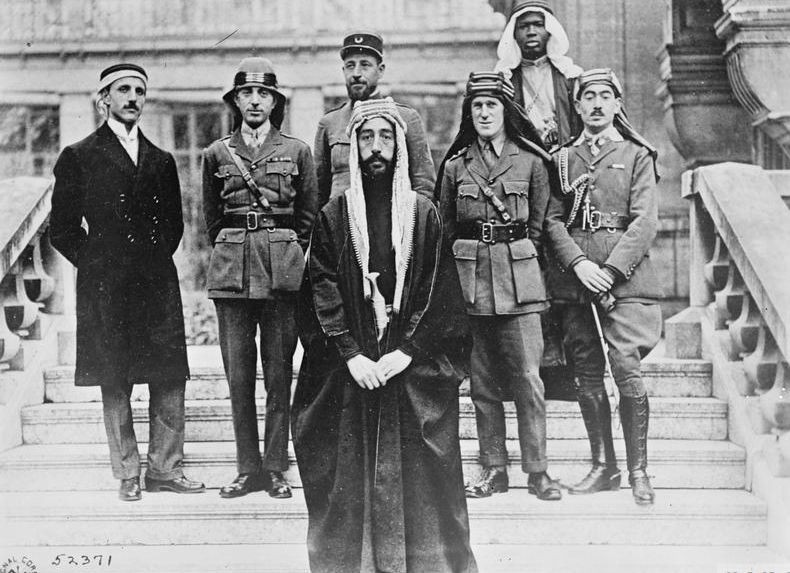
During the
discussions during and following the Paris Peace Conference in 1919 the British
authorities – in London, Paris, and the Middle East – gradually came to realize
that, in contrast to what they had initially believed, they could not dictate
terms to the French with respect to Syria. When the peace conference opened in
January 1919, they might have differed among themselves about the best way to
secure British interests in the Middle East, but they all shared the
presumption that Great Britain could negotiate with the French from a position
of strength. It was only a question of time before the latter would understand
that they had no other option than to give in to British demands. British
forces occupied the country, the USA strongly opposed French imperialistic
designs, and if France nevertheless succeeded in pushing through her ambitions
and tried to occupy the country, Arab armed resistance would lead to bloodshed
on a scale France could scarcely afford. It was only through Britain’s good
offices that France would be able to secure Syria by peaceful means. By the end
of August it had become clear that all this had been an illusion. In January it
had already been realized that the costs of occupation constituted an
intolerable burden for the British treasury, but there remained the possibility
of American intervention and there was still the threat of the Arab
nationalists attacking French soldiers. By May, however, everything indicated
that the Americans would not take a stand on Syria, and by July the Arab threat
more or less evaporated as a result of a more realistic appreciation of the
strength of the Arab forces under Faisal’s command. Prime Minister David Lloyd
George nevertheless thought he could still settle matters in Britain’s favor by
presenting the French with the fait accompli of a British evacuation of Syria
as of 1 November, and handing over the towns of Damascus, Homs, Hama and Aleppo
to Faisal’s forces in pursuance of the British agreement with the Emir of
Mecca. He believed that French prime minister Georges Clemenceau would not dare
run the risk of an armed confrontation. Clemenceau did not even blink. He
demanded that the British put a stop to their meddling in the Syrian question,
and leave it to the French to deal with Faisal and the Arab nationalists. By
the middle of October, it was Lloyd George who gave in. Faisal was left to fend
for himself.
The French, who
opposed his plan, defeated his army in July. But even if they hadn’t, Faisal’s
territorial claims would have put him in direct conflict with Maronite
Christians pushing for independence in what is today Lebanon, with Jewish
settlers who had begun their Zionist project in Palestine, and with Turkish
nationalists who sought to unite Anatolia.
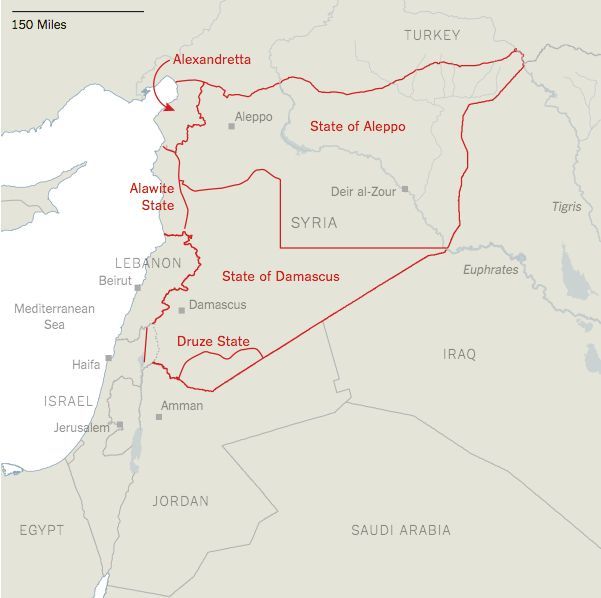
In conclusion, it is possible
to understand Britain’s contradictory policy commitments which were made as
British war aims evolved along with the conditions produced by the
conflict. What they understood about the connection between the
Hashemite family and Arab nationalist societies differed from the actual
relationship.
Another leitmotif was
that the officials at the Foreign Office had no thought-out conception of what
British Middle East policy should be, but judged developments in that area by
the simple rule that nothing should be done that might arouse France’s susceptibilities
on Syria.
And while it is
significant that in 1917, Britain somehow expected an Arab-Islamic empire to
take shape. British policymakers were never fully aware of the social and
political connections between the Hashemites, the secret societies called Fatat
and 'Ahd, and the pan-Islamists. This is because they
did not understand, or chose to overlook, how deeply engrained religious
notions of power were within these secret societies.
At the end of the war, Sharif Hussein was left only
with the stony and unproductive Hejaz, in which he imposed a regime of
ultrastrict shari‘a, restoring punishments such
as hand and foot amputation which had fallen into disuse in the region long
before the Young Turk revolution. At the same time, he began to behave
increasingly like the archetypal ‘oriental despot,' alienating rich and poor alike.
In March 1924 Hussein proclaimed himself caliph after the Turkish
Nationalist government had formally abolished the role. In response, ‘Abd
al-‘Aziz Ibn Sa‘ud of Najd sent his feared
Ikhwan fighters into Hussein’s realm and the king was forced to flee to
‘Aqaba in ‘Abdallah’s Transjordan, from where the British removed him to
Cyprus. He later returned to Transjordan’s capital, Amman, where he died in
1931.
It should therefore
not come as a surprise that Amman was foremost in celebrating, what inspired by T.E.
Lawrence is today, called the 'Arab Revolt'.
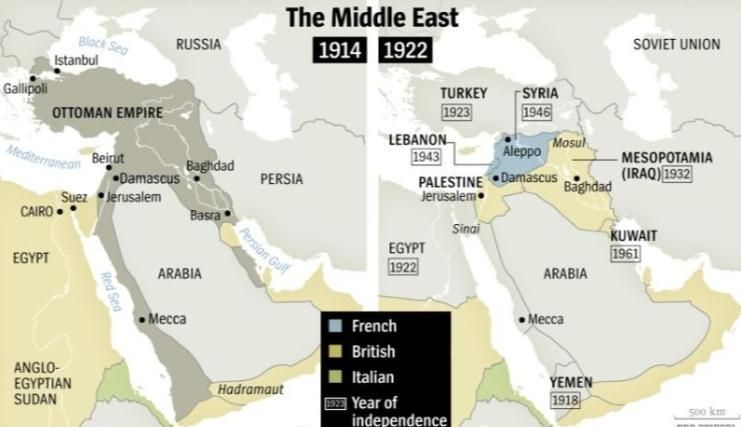
Conclusion: From Sherifian to
a real ‘Arab revolt’ in Iraq
If we were to ask the
question, ‘On whose side did the Arabs fight in the First World War?’ Most
people who know something about the war’s history would probably say
‘Britain’s.' Such a reply would reflect the orthodox account,
emanating from the glorification of ‘Lawrence of Arabia’ and the alleged ‘Arab
Revolt’ of Sherif Hussein and his sons, an episode also burned into the
imagination by David Lean’s spectacular and immensely popular film on this
subject. In both the film and Lawrence’s original memoir – The Seven Pillars of
Wisdom – we see an epic struggle in which ‘the Arabs’ join with the British in
a fight to the death against the former’s cruel Turkish overlords. In return,
the British promise the Arabs ‘freedom’, for their contribution to winning the
war in the Middle East, a promise which would never be redeemed. This ‘orthodox
narrative’ is also exemplified by the writings of some Arab historians who
interpreted the pro-British stance of the Hashemites as part of an ‘Arab
awakening’ after centuries of Turkish domination.
However, over the
last two decades, this orthodox narrative has been questioned by a number of
historians – not just the role claimed by Lawrence himself, but more
fundamentally the assumption that Britain’s opponents in the Middle East were
almost entirely ethnic Turks, that the Arabs’ experience of the Ottoman state
was little more than a ‘Turkish yoke’, and from the outset they were only
waiting for an opportunity to rebel against it.
In reality, the vast
majority of Arabs did not ‘fight for the British’ in the First World War. In
1914 about one-third of the regular troops in the Ottoman army were Arabs,
mainly from the towns and cities of the regions which subsequently became Iraq,
Syria, Lebanon and Palestine.
However, between July
1920 and February 1921, in the territory then known to the British as
Mesopotamia – the modern state of Iraq – an Arab uprising occurred which came
perilously close to inflicting a shattering defeat upon the British Empire. The
story of this uprising is one which once engaged the closest of attention among
the British public but over many decades slipped back into the mists of
exclusively academic history, almost completely erased from the collective
memory.
And so it would have
remained had it not been for the ill-fated US invasion of Iraq in 2003. Once
the ‘insurgency’ against the subsequent occupation had begun, it wasn’t long
before a much older, forgotten insurgency in Iraq came to light with journalists,
historians and even functionaries of the US occupation drawing lessons and
making comparisons – some appropriate, some less so – with that much earlier
event.20
The Iraqi revolt
against the British, also known as the 1920 Iraqi Revolt or Great Iraqi
Revolution, started in Baghdad in the summer of 1920 with mass demonstrations
by Iraqis, including protests by embittered officers from the old Ottoman army,
against the British occupation of Iraq. The revolt gained momentum when it
spread to the largely tribal Shia regions of the middle and lower Euphrates.
Sheikh Mehdi Al-Khalissi was a prominent Shia
leader of the revolt.
Sunni and Shia
religious communities cooperated during the revolution as well as tribal
communities, the urban masses, and many Iraqi officers in Syria. The objectives
of the revolution were independence from British rule and creation of an Arab
government.
The Foreign Office (FO) documents can be viewed
online, here:
http://www.nationalarchives.gov.uk/help-with-your-research/research-guides/foreign-commonwealth-correspondence-and-records-from-1782.
1. Fromkin, David (1989). A Peace to End All Peace:
The Fall of the Ottoman Empire and the Creation of the Modern Middle East. New
York: Owl. pp. 286, 288. ISBN 978-0-8050-6884-9.1 Tauber, The Arab Movements in
World War I, pp 63–65.
2. Note, not dated,
encl. in Abdullah to Storrs, 14 July 1915; Antonius, Arab Awakening, p. 414.
There were four other conditions, which McMahon summarized as
follows: ‘Arab government of Sheriff to guarantee Great Britain economic
preference in Arab countries. Conditions of mutual assistance. Great Britain to
approve and further abolition of foreign privileges in Arabia. Provisions of
renewal of alliance.’ Tel. McMahon to Grey, no. 450, 22 August 1915, FO
371/2486/117236.
3. Clayton to
Wingate, private, not dated, presumably March 1915, Wingate Papers, box
134/4.
4. Clayton to
Wingate, private, 21 August 1915, Wingate Papers, box 135/2.
5. Storrs, Note, 19
August 1915, FO 371/2486/125293.
6. Tel. McMahon to
Grey, no. 450, 22 August 1915, FO 371/2486/117236.
7. Minute Clerk, 23
August 1915, on Shuckburg to Oliphant, 13
August 1915, FO 371/2486/112369.
8. Quoted in Roger
Adelson, London and the Invention of the Middle East: Money, Power, and War,
1902-1922,1995, p. 190.
9. FO/882/13, The
National Archive, London, Memorandum on Military, Political Situation in
Mesopotamia (Section II), 28 October 1915.
10. Quoted in
Adelson, p. 74.
11. Ibid., pp. 107–8.
12. Minute Clerk, 3
December 1915, on Parker to Clerk, 3 December 1915 (underlining in original),
FO 371/2486/183416.
13, Minute Grey, not
dated, on tel. McMahon to Grey, no. 732, 28 November 1915, Cab 37/138/ 23.
14. Chamberlain to
Hardinge, private, 25 November 1915, Hardinge Papers, vol. 121.
15. Clerk’s minutes
of meeting Nicolson committee with Georges-Picot, on 23 November 1915, 1
December 1915, and minute Nicolson, 27 November 1915, FO 371/2486/ 181716
16. Clayton to
Wingate, private, 24 September 1916, Wingate Papers, box 140/6.
17. Tel. Wingate to
Balfour, no. 645, 18 June 1917, FO 371/3048/121588, tel. Wingate to Balfour,
no. 754, 18 July 1917, FO 371/3048/142636.
18. Treasury to F.O.,
no. 32359/17, 10 October 1917, FO 371/3048/195477.
19. Tel. Wingate to
Balfour, no. 1153, 2 November 1917, and minutes Clerk and Graham, 3 November
1917, FO 371/3048/210013.
20. See, e.g., Niall
Ferguson, ‘This Vietnam Generation of Americans Has not Learnt the Lessons of
History’, Daily Telegraph, 10 April 2004; Robert Fisk, ‘Iraq 1917’,
Independent, 17 June 2004; also, before his replacement, Paul Bremner, head of
the Coalition Provisional Authority set up to administer Iraq following the
invasion, was reported as opining that the great mistake of the Shi‘is had been
to rebel against the British in 1920. See also The Iraqi Independence Movement:
a Case of Transgressive Contention (1918–1920) and Aula Hariri Sectarianism in
Iraq: The Making of State and Nation Since 1920 By Khalil Osman 2014.
For updates click hompage here